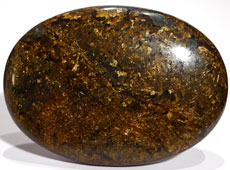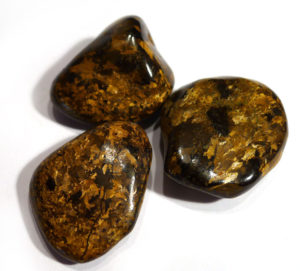Properties:
Bronzite is a variety of enstatite.
Enstatite (general) is lively, friendly, and can have a mood-lifting effect. It helps us to re-charge the body’s flow of energy while keeping our feet firmly on the ground. It calms the mind, and helps to release tension held in the body, which in turn can have a pain-relieving effect when the pain is a direct result of tension (such as a tension headache). It aligns and awakens the major chakras, with a particular emphasis on the Sacral Chakra. It “shines a light” internally, so we become aware of any areas in need of work, particularly on a physical level. Enstatite can be useful in regression work, including past life regression.
Bronzite shares the qualities of brown ferroan enstatite. It strengthens connection and communication between cells, and thus the general flow of energy throughout the body. As with enstatite, it draws our awareness to the areas of the body in need of attention, and instigates a healing process. In addition, bronzite aids self-realisation and self-acceptance.
Attributes:
- Chemical Formula: (Mg,Fe2+)2[SiO3]2
- Group: Silicates – inosilicates (single chain)
- Crystal System: Orthorhombic
- Hardness: 5-6
- Birthstone: Secondary birthstone for Leo
- Chakra: Earth, Root and Sacral
- Element: Earth
Mineralogy:
Enstatite is a common rock-forming mineral in the pyroxene group. It most commonly forms as massive aggregates, but occasionally forms well-developed short prismatic crystals. Gem-material material has been mined in the localities of Mysore, India, Canada, Sri Lanka and Myanmar. It has no industrial uses, but is mined commercially as a gemstone.
Enstatite forms a solid-solution series with ferrosilite (FeSiO3), meaning that iron (Fe) substitutes for magnesium (Mg), creating a series of closely related minerals depending on the level of iron to magnesium. Bronzite, which is brown with a metallic lustre, hypersthene, which is grey with an interesting play of light, and ferroan enstatite, which is also brown, are all mid-range members between enstatite and ferrosilite. The name hypersthene is now considered redundant by mineralogists, and is generally called ferroan enstatite.
History and Tradition:
Enstatite was named from the Greek enstates – “opponent” for its refractory nature under blowpipe flame (according to MinDat). Ronald Bonawitz states that it is used as a refractory to line ovens and kilns, and therefore “opposes” heat. Bronzite is presumably named for its bronze colour and metallic lustre. Due to its relatively recent discovery, there are no traditions associated with this series of minerals.


